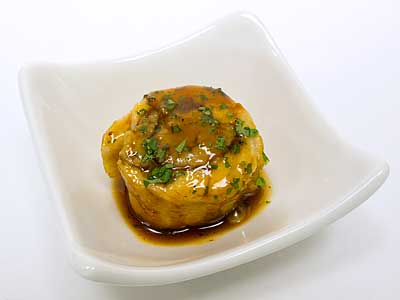October 3, 2011
Amuse-Bouche

aile de poulet farcies
(stuffed chicken wings)
Last summer, when I was videoing the various steps required to cut up a chicken, I wound up using four or five dismembered chickens from the shoot. As each was cut into various portions, I had to decide what to do with the results of my knife work. Unlike professional shoots I’ve worked on, I didn’t want to just toss the chicken pieces onto the trash heap after their “15 seconds of fame.” Various pieces went into different dishes, and after boning out the wings, I had a unique opportunity staring up at me from my cutting board: four empty “sacks” of skin and muscle, two from each wing. It was time for a new amuse-bouche.
A number of years ago I posted a recipe for jambonneau de volaille aux abats rouge, stuffed chicken legs, that seemed like it would make an ideal adaptation by using wings. Unfortunately, that recipe called for a particular filling that would have been too time consuming on the morning I wanted to stuff the wings. Luckily, I had some fresh saucisse de Toulouse, Toulouse-style pork sausage, handy to use as a stand-in for the farce in the jambonneau recipe. I simply filled the wings with the bulk sausage. The wings were filled a bit loose since the skin stretches so easily and if ballooned out, it would be difficult to properly shape the wings into little sausages and not have the result look like the wings of a Super Chicken.
The sausage meat made for a simple meat filling, but you could use any filling that will hold its shape when cooked. Any meatloaf or pâté recipe would work fine. A bread stuffing would work good, but I’d probably cook and cool it before filling the wings. Whatever filling you use, remember that the meat on chicken wings is fairly mild, and the flavorings of the filling should’t over power it.
Once the wings are filled, it’s necessary to shape them. I roll each one separately and very tightly into a piece of plastic wrap so the filled wing takes on a short, stubby sausage shape. I attempt to make all of them the same diameter. Once the “roll” is done, the ends are twisted to force the wing and it contents into a round shape. The twisted ends are folded under and the whole package wrapped into an additional piece of plastic wrap. The wing packages are then placed in a vacuum bag, and spaced so the bag will individually collapse around each “sausage.”
At this point, there are two paths that can be followed. The stuffed wings can be cooked and served immediately, or they can be cooked, chilled, and reheated for service, which is my preference. By cooking the wings ahead of time, I can precook the entire batch, freeze them, and then reheat as many portions as I need for a party. No matter which path is chosen, the package of wings is cooked in 60 °C (141 °F) water for the time required by the maximum thickness of each chicken package. Because of the use of ground meat, I like to shoot for a 6D bacterial kill in the cooking time calculation.
When the wings are finished cooking, if not being served right away, the whole bag is chilled in an ice-water bath. The plastic wrap will contain liquid exuded from the wings, so I’ll unwrap each one, discard the liquid, dry off the wing’s surface, and rewrap it tightly in a single piece of plastic wrap. The individual wings are then packaged in a single bag and placed in the freezer until needed.
The day before I plan to serve the wings, I move the appropriate number of wing packages—each wing portion makes two amuse-bouche servings—to the refrigerator for thawing. An hour or so before serving, I move them from the refrigerator to the water bath. The temperature of the bath can be pretty much whatever I’m using for other items. Once the chicken and stuffing is cooked, it won’t cook again. As long as the temperature of the water is sufficient to reheat the wings, that’s all that’s required. At this point, there shouldn’t be any concern with interior bacteria.
For service, the wings are removed from their packaging and the surface dried. I quickly brown them in a frying pan with a little very hot oil. I make a quick sauce by melting a little glace de volaille and thinning it with a little Madeira wine. I also will add a bit of salt since my glace never is salted during its production. Once browned, the wing pieces are cut into two portions and plated, cut-side-up, on two plates with a little sauce. A light sprinkle of some minced, fresh herbs completes the presentation.
© 2011 Peter Hertzmann. All rights reserved.
